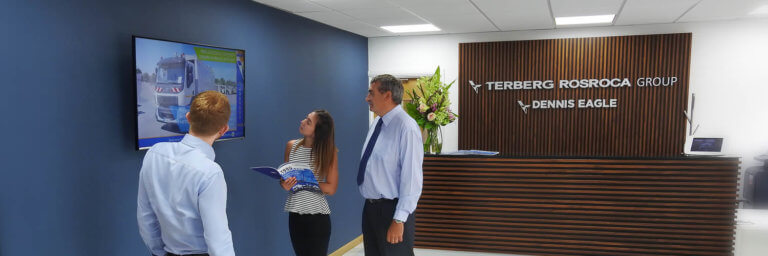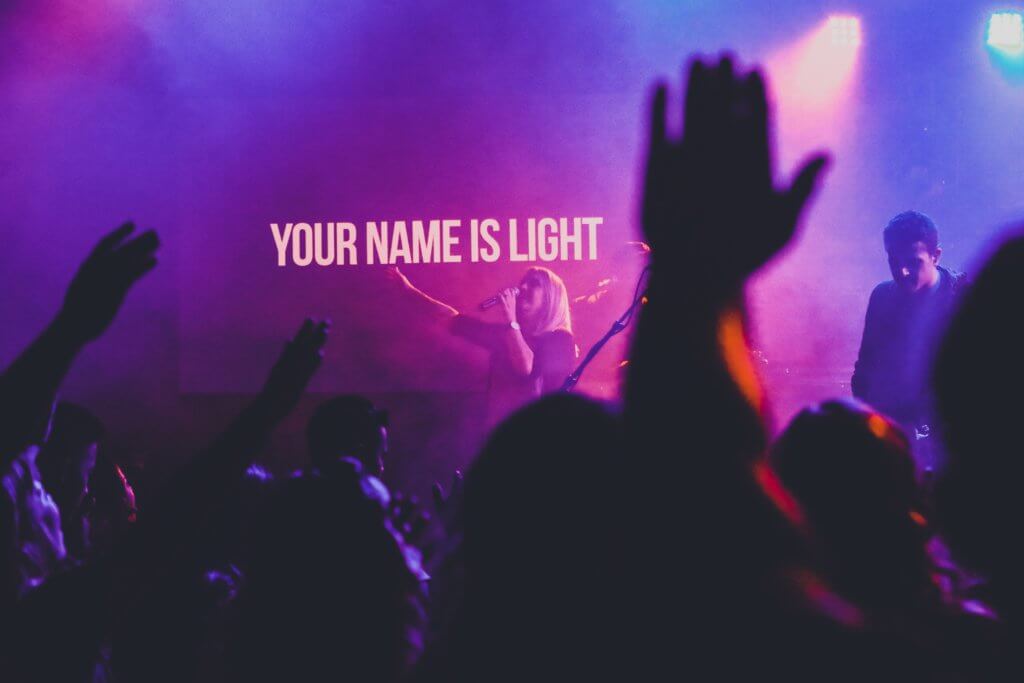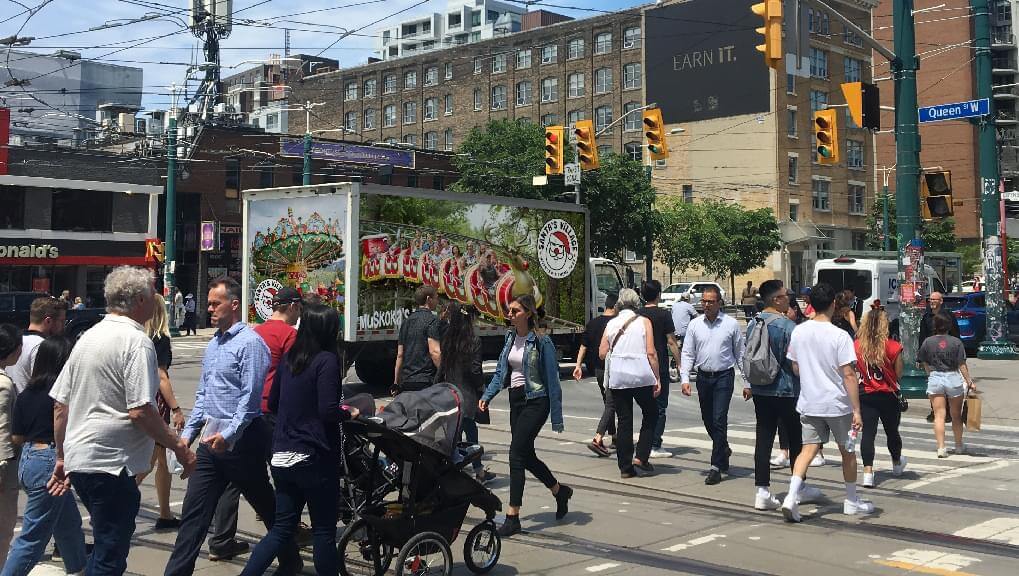
This is the second blog post in our series comparing mobile truck billboards to other OOH advertising mediums. As the newest kid on the block, it made sense to talk about digital signage, its benefits and drawbacks, and how it compares to mobile truck advertising. Both forms of advertising are creative forms of outdoor advertising. They save advertisers and brands money while generating buzz. But like any tool in your belt, knowing when to use them is important. Let’s take a look at these two and see which would work best for your next campaign.
DOOH Advertising Basics
Digital signage is everywhere. Earlier forms used liquid crystal display (LCD) screens to project images that refresh between every 8-15 seconds. These early screens were more energy-intensive than today’s light-emitting diode (LED) screens. As we have written about previously, since it came out it has been making great gains in the market share. Part of the reason why—digital signage comes in all different shapes and sizes.

Different Sizes For Different Spaces
Meaning that spaces from dentist offices to Times Square can be home to digital signage and DOOH advertising. Sabercom breaks down the types of screens available and what they are most often used for. For smaller set ups, digital televisions are better for price and more common. Larger installations are often either video walls or projector screens. Manufactured by companies such as Samsung, there are plenty of options to choose from for digital signage panels. While there are standard panel sizes out there, many manufacturers offer custom sizing for those that need it, but be prepared to pay extra for it.
Where Can It Go?
For advertising, DOOH can be come in many different forms:
- Public transit: Digital signage can replace traditional advertising on bus shelters and train stations walls. Airports also make great spaces for digital screens.
- Mobile DOOH- Trucks have been seen from San Francisco to Las Vegas with outsized digital screen panels covering their sides.
- Billboard Spaces- Almost anywhere a traditional billboard can be placed, a digital one can be as well. All it needs is a dedicated power source, a media player, and away you go!
- Retail and Commercial Spaces- Malls, movie theatres and markets are all spaces where the shift to digital can happen. From smaller 2 ft by 9 ft movie advertisement panels to larger ones used to navigate malls, they can also be found in neighborhood watering holes, concert and sports venues.
- Medical Centres- Hospitals, dentist offices, and other medical facilities benefit from what digital signage has to offer.

How is DOOH installed?
Sabercom’s guide on digital signage goes into depth on what is needed to install DOOH or digital signage. Companies interested in installing digital signage will be happy to know that most small sizes only require a wall mounting bracket or stand, a power source, and a media content player to run content from. The larger digital billboards and video walls can range in complexity depending on the size and location of the media.
The guide also cautions on the content player used. Noting that there are many options for devices—like computers, “dedicated digital signage players”, and chip-based systems—that can be used to run content. Smaller installations can be run off DVD players, streaming devices, or digital signage players. PC’s are a better option for larger signage or ones needing higher graphics capacity or a faster processing time. While computers tend to be the most used due to ease of use and familiarity, smaller businesses might find that cost high.
If you choose the computer route, though, beware. As with any product, the rule with computers is that you get what you pay for. Using a lower-end or slower computer may add costs like wasted time and insufficient processing power—especially with 4K or 8K content.
Regardless of which options you choose, once the installation is done, this is where DOOH’s benefits kick in.
Advantages for Companies
- Saves Time-For DOOH or digital signage owners/operators, there is no need to tear down ads between campaigns like they would have to with traditional paper or vinyl OOH ads. As the files are sent electronically, this cuts down on time spent travelling to and from the printers, installation, and labour.
- Save Money-As mentioned above, labour costs; including installation and maintenance are lower than traditional OOH. As these ads produce their own light, there is no need to worry about burnt-out lamp bulbs or broken lighting.
- Run Simultaneous Campaigns- Unlike traditional OOH, which can only run one campaign in a specific location at a time, digital signage has programming flexibility, allowing multiple ads, or even interactive ads to be run.
Advantages for Advertisers
- Flexibility- One commonality that digital OOH has with mobile truck advertising is in its flexibility. Unlike traditional billboards, digital billboards and signage does not lock down advertisers and clients to fixed periods for buying space. Traditional billboard space generally has to be rented in two-to-four-week periods—making it less feasible for shorter campaigns or smaller budgets.
- No Printing Limitations- With 4K and 8K screens becoming more popular, choosing this route means graphics can be exquisitely rendered and head-turning.
- Impressions- Statistics show that DOOH outperforms traditional OOH in generating impressions and ad recall.

So, it’s no wonder that its adherents love it for its ease of use after installation and because the digital screens can cycle through different content at a regular pace. This makes it a great product for corporate environments—the smaller screen versions can be used to update employees and visitors of important milestones or provide essential information. For signage or billboard companies wanting to advertise more than one product with a single screen, this seems like a win/win situation.
Like every tool, though, DOOH has its flaws.
Planned Obsolescence
Another fact to note is that most electronics these days are built to last for only a few years. Meaning that while maintenance on them will not be a regular concern, they will need to be replaced in the future. For example, LED’s in the screens have, on average, a lifespan of 50-60,000 hours. That seems like a lot at first glance; however, as there are 8766 hours in a year, this averages out to 5.7-6.8 years. As these bulbs are sensitive to extreme temperatures, in hotter or colder areas the lifespan may decrease dramatically. With digital panels ranging in cost from $4000- to over $154,000, this adds up quickly. Factoring in future costs for companies is an important consideration. This also impacts the device’s overall carbon footprint.
Sustainability
E=MC2. Energy can neither be created nor destroyed. All electronic devices use electricity to run. While LED screens are less energy-intensive than their LCD predecessors, the amount of DOOH installed worldwide and their power usage quickly adds up. As we noted in a previous article, “a digital billboard may consume up to 30 times of energy than an average American home uses.” While strides have been made to create solar-powered DOOH installations, there are costs that need to be factored in when considering digital signage.
The ecological cost of the electronics themselves needs to be factored in as well. “The manufacturing of a monitor is a complex process, involving many hazardous materials as well as precious metals. “ (Bhakar, et al. Environmental Impacts of an LED Monitor Production). Recycling these components is available in many areas; however, the lifecycle impacts of digital technology cannot be ignored. Currently, we generate “16 pounds of e-waste for every one of the 7.8 billion people living on Earth.” E-Waste is the fastest growing form of waste out there and it’s expected to increase by 100 percent by 2030. So if you or your clients are concerned about a campaign’s ecological footprint, digital may not be the way to go.
Technical Issues
As technology becomes more complex, the more likely it is that something can happen. From internet or power outages to software glitches or programming errors. Traditional billboards or mobile truck advertisements do not need Broadband to operate, nor are there concerns about someone accidentally unplugging the wrong cord.
Advertising Costs
While costs are expected to go down as more companies adopt this technology, right now DOOH is more expensive than traditional OOH. Costs depend on a few factors such as campaign length, billboard size, whether the advertiser rents out the unit completely for the entire time period or ads rotate between businesses. Check out our blog on DOOH costs here.
Location, Location, Location
With their power requirements, static nature, and technical issues there are many places where digital signage may not work or it may be too expensive to install. This includes remote townships, rural areas, and highways. Areas where the populations do not have a high enough density to warrant the cost of installing and maintaining digital signage may become a factor in determining which advertising method to choose.

The Mobile Billboard Difference
Mobile truck advertising campaigns are lower cost than traditional OOH campaigns. Because of their mobile nature, these trucks have proven to work well in more remote locations-reaching audiences that digital OOH cannot. Similar to digital signage and DOOH, mobile truck advertisements work well for shorter campaigns, ones requiring a creative or more targeted approach. It is quite common for campaigns to use both mediums at the same time for better audience penetration.
When it comes to sustainability, mobile truck advertising can be a better option. For example, if the truck wraps used are recycled at the end of the campaign, if the company uses delivery trucks that are already in use or commits to sustainable business practices. If sustainability is a concern, then it is important to ask questions to determine if the provider is the right fit for you.
However, as we discussed previously, one of the drawbacks of mobile truck advertising is that it is harder to see from a distance, especially in dense populations. So, if you are looking for an option that rises above the crowd, opting for a digital billboard may be a better fit for you.
Final Thoughts
For OOH advertising, there are plenty of options out there. As the newest player in the game, digital OOH can offer a lot to those looking to make a splash. Considered the future of advertising, it pairs well with other OOH mediums, is flexible when it comes to rental length, and offers crowd-pleasing interactive options. Its easy installation and programming make it more convenient for owners and advertisers alike. However, it does have its drawbacks. From cost to technical issues to environmental impacts, there are still wrinkles that need to be ironed out.
These concerns show that there is still a place for mobile truck advertising. More environmentally friendly, with lower costs and the ability to reach those that traditional OOH and DOOH cannot, mobile truck ads can pair well with DOOH or be used as a standalone option. Advertisers have a lot of factors to consider when choosing mediums for their ad campaigns. We hope this post has helped inform you as to how these two advertising forms work and their benefits and drawbacks.


